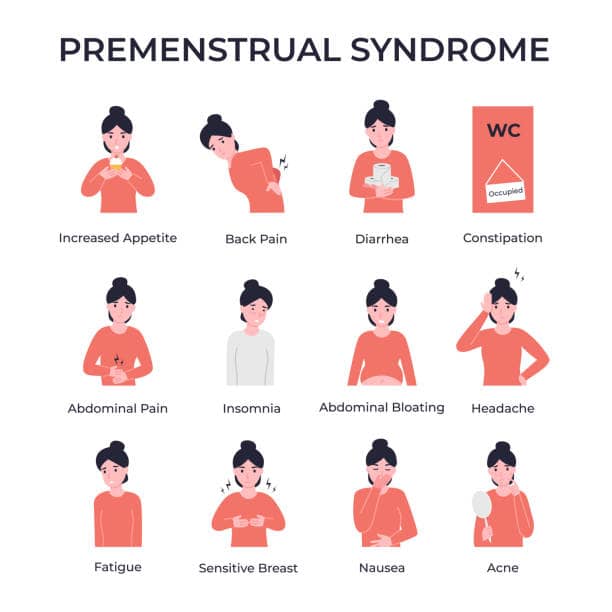PMDD or Premenstrual dysphoric disorder is a chronic kind of premenstrual syndrome (PMS). PMDD has similar symptoms to PMS symptoms but are severe enough to cause major hindrance in personal relationships, social behavior and work.
PMDD is known to occur in two to twenty percent of women that menstruate. Those women with a personal or family past of depressive tendencies or postpartum depression are more prone to developing PMDD.

Table of Contents
PMDD Causes:
- The precise reason for developing PMDD is still vague, much like PMS. However, many scientists believe that the hormonal variation associated with the menstrual cycle is the probable reason behind developing PMDD.
- Latest research has revealed a strong link between PMDD and depleted levels of the feel-good hormone serotonin – a chemical present in the brain that aids in the transmission of nerve impulses. Particular types of brain cells that employ serotonin as an envoy are involved in managing pain, mood variations, attention levels, and sleep patterns. Hence, chronic variations in the levels of serotonin could cause niggling PMDD symptoms.
PMDD Symptoms:
The signs of PMDD could involve any of the following:
- Moodiness.
- Depressive mood swings or feeling a sense of bleakness.
- Noticeable rage, heightened inter-personal clashes.
- Nervousness and disquiet.
- Touchiness and bad temper.
- Lowered interest in routine activities.
- Decreased concentration levels.
- Weariness.
- Appetite changes.
- Feelings of not being in control or weighed down.
- Difficulty in sleeping.
- Physical issues like feeling bloated.
Diagnosis & Tests:
- If one is experiencing any of the above-enlisted symptoms, it is imperative to seek prompt medical assistance. The doctor would re-evaluate the symptoms, medical past, followed by a detailed medical exam and an optional psychiatric assessment.
- Before diagnosing PMDD, other emotional issues like depressive tendencies or panic disorder would be systematically ruled out by the doctor to explain the symptoms.
- Additionally, any underlying conditions, either medical or gynecology-related, must be ruled out that could include diagnosing for endometriosis, fibroids, menopause and hormone-related problems that might also account for the signs.
- PMDD is concluded when no less than 5 of the above-enlisted symptoms (inclusive of at least one symptom from the top four symptoms) transpire during most periods during the seven days before the monthly periods starting and subsides within a couple of days from the commencement of the menstrual cycle. When these symptoms are a daily occurrence and do not seem to get better with menstruation, they are not likely to be due to PMDD.
PMDD Treatment:
Several similar stratagems employed for PMS might additionally be useful to allaying PMDD symptoms. The four key kinds of treatments comprise of:
- Several health care experts advise women with PMDD to curb their ingestion of sodium, caffeine, white sugar and intoxicants. Intake of certain supplements like calcium, vitamin B6, vitamin E and magnesium might be advised. The effectiveness of any of these strategies has not been adequately determined as yet.
- Engaging in the traditional form of aerobic exercise like walking, swimming has been observed to reduce the bothersome symptoms of PMS. However, it is ambiguous whether it could help resolve PMDD.
- Who could treat PMDD with numerous antidepressants like the three key FDA-approved ones, including Sarafem, Paxil CR, and Zoloft, to relieve the symptoms? These medicines could be consumed on a continual or intermittent basis, merely during the fourteen-day premenstrual period. Intermittent use of these might lower the side effects of those drugs.
- Certain over-the-counter pain killers like aspirin, ibuprofen or Motrin, naproxen or Aleve might help relieve some signs like headache, back pains, cramps and tenderness in breasts. Diuretics, also known as water pills, could aid in water retention and bloating. Who will advise Anti-anxiety medicines if anxiety is one of the symptoms? Presently, none have received approval for the treatment of PMDD.
- Hormone treatment could be undertaken for treating PMDD. The ovulation could be halted by either the use of medicines or surgery when nothing else works. Medicines for ovulation stoppage comprise birth control or OC pills, Danazol, Synarel and Lupron. The hormonal treatment strategy involving progesterone or estrogen usage could be used for relieving symptoms, though it is undecided regarding the efficacy of this strategy.
- Therapies to aid women in handling PMDD include relaxation therapy, meditation, reflexology and yoga, though these approaches still need detailed investigation.
Alternative remedies

Potential Choice Treatments that Who tried for PMS and Can Aid with PMDD Include Things like:
- Yoga
- qi treatment
- saffron treatment
- guided vision
- photic stimulation
- acupuncture
But a lot more study is necessary to verify the efficacy of those treatment options.
Diet Plan and Exercise

Dietary adjustments comprise:
- Diminishing ingestion of salt, sugar, caffeine, and Liquor
- raising intake and protein of complicated carbs
- Physical exercise, tension control methods, and support in seeing menstruation can provide help in a certain light.
Other hints
Additional plans that can help trusted Supply Things like:
- Carrying It Simple about the times Before menstruation
- speaking to some spouse or reliable buddy
- Discovering relaxing actions that alleviate stress, for example like studying, viewing a film, Opting for a stroll in, or even using a tub
Consult with your healthcare provider at once if you believe that you could well be suffering from PMDD symptoms.
Whilst the symptoms of PMDD might be long-term, it’s wise to find treatment once you possibly can.




